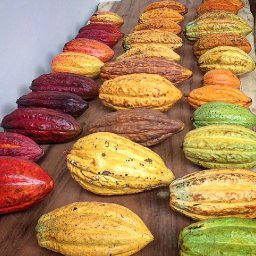Raw chocolate-- what is it really?
Chocovore - Scores will also vary widely based on the variety. For example, one of the reasons criollos are pale is that they have lower concentrations of polyphenols. So they will have lower ORAC scores right out of the pod. To really generalize: The darker the bean, the higher the concentration of polyphenols, and the higher the ORAC score. But not always.
--
~~~~~~~~~~~~~~~~~~~~~~~~~~~~~~~~~~~~~~~~~~~~~~
@DiscoverChoc
updated by @clay: 07/01/17 10:37:01
updated by @sacred-steve: 09/08/15 20:09:14
--
~~~~~~~~~~~~~~~~~~~~~~~~~~~~~~~~~~~~~~~~~~~~~~
@DiscoverChoc
Dear Samantha, I don't have a lot of confidence in that report only because they are reporting such a huge swing in the min and max values (202 to over 1000) for a 100% cacao bar (the 1000 level was probably gotten from a bar where the beans were not roasted and the 202 value was probably from a bar where the beans were minimally roasted; The more you roast, the more you blow out the antioxidants--this is a repeatable experimental fact.) Even the cocoa (cacao) powder which is devoid of about 80% of the cocoa (cacao) butter is reported to be in the 600 range on average with a much smaller range in min and max values probably because they do much of the pressing in the industry before the beans are roasted. On a per weight basis since it is much more concentrated, it should be much higher than the bar.
--
~~~~~~~~~~~~~~~~~~~~~~~~~~~~~~~~~~~~~~~~~~~~~~
@DiscoverChoc
Thanks Clay for that added clarification!
The unit notation umoleTE/g means micromole of trolox equivalents per gram. That is a mistake actually!
Thanks for pointing that out! The bean we use is officially called "Arriba Nacional Aromica". It is sourced from Ecuador.
Hearts!!
Sacred Steve
In the article you reference on agave nectar, you start out talking about maple sugar and mention that you use "Criollo Aromica Ecuadorian" beans to make your chocolate. I have never heard of this kind of bean. Can you let us know more?
Also, could you please explain for everyone what "600 umoleTE/g" means, not just spell out the technical terms.
ORAC stands for Oxygen Radical Absorption Capacity but people may not know what that means.
Thanks,
:: Clay
--
~~~~~~~~~~~~~~~~~~~~~~~~~~~~~~~~~~~~~~~~~~~~~~
@DiscoverChoc
updated by @clay: 07/01/17 10:34:50
updated by @sarah-hart: 12/13/24 12:16:49
Tags
Activity
Our first podcast episode, Chocolate is Multiple, is live. Please listen and share your feedback!
TheChocolateLife celebrates its 9th anniversary this week, starting publication the week of January 18, 2008. Already planning a 10th Anniversary bash!
Food and Wine Magazine's list of top chocolates in the US.
This appears to have been put together by a committee (there is no byline) and by people who have little or no understanding of the chocolate business. Like most lists produced this way, it's very uneven - mixing very small producers with global mass-market brands, and not differentiation between chocolate makers and confectioners.
What are your thoughts?
This year 2016 was a good year for our small business in Belgium. We now are following some new (for us) small and unique chocolate makers. Such as: Ananda (Ecuador), The Wellington chocolate Factory, Acali, Potamac, Letterpress, PumpStreet Bakery, Dick Taylor and La Naya. We are proud to be the smallest chocolate shop in Belgium following some of the best chocolate makers in the world.
Wishing you all a Merry Christmas and a happy New Year 2016/2017




